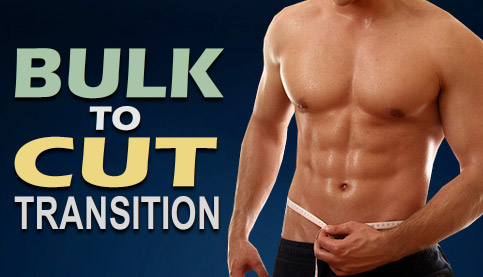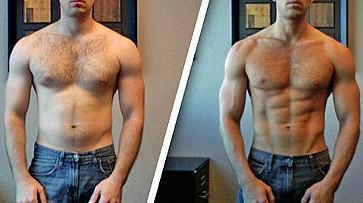HOW TO PROPERLY TRANSITION FROM BULKING TO CUTTING

A few weeks ago I wrote a post explaining how to transition from cutting to bulking for those who had just finished up a fat loss phase and were ready to start gaining more overall mass.
I received quite a few questions in response to that article from readers who were at the other end of the spectrum and wanted to know how to properly shift from bulking to cutting instead.
So, that’s exactly what I’ll be covering today.
What is the best way to transition into fat burning mode and strip off that excess “fluff” you accumulated during your muscle building phase?
(I’ve covered “mini cuts” in another post, so for the purposes of this one, I’m talking about prolonged phases of bulking and cutting.)
Here’s how to go about it…
The Purpose Of The “Pre-Diet Phase”

An effective bulking to cutting transition is actually very straightforward, and I wouldn’t recommend over-complicating this or turning it into some long drawn-out process.
You don’t need to spend week after week after week slowly dropping your calories in tiny precise increments, as this is simply unnecessary and will only prolong the amount of time it takes for you to reach your desired level of leanness.
As long as you’re continuing to follow a properly structured weight training plan, are consuming a sufficient amount of protein each day, and are not drastically cutting calories in combination with huge amounts of extra cardio, muscle and strength loss are not going to be a concern when dropping into a calorie deficit.
Rather, the main purpose of the “pre-diet phase” is to keep your hunger levels under control and to maintain your physical/mental energy as you shift into your cut, rather than “shocking” your system with a large calorie decrease overnight.
If you’ve been eating in a calorie surplus over a prolonged period of time in order to gain muscle, your body will have gotten used to that higher food intake and your appetite and hunger signals will have adapted as well.
If your intake for bulking was set at 3000 calories per day and you immediately drop straight to 2000 calories in combination with extra weekly cardio, you’ll likely find yourself feeling excessively hungry, physically drained, and with a much harder time focusing on regular day to day tasks.
This will make the first few weeks of your cut much tougher to follow, and your chances of actually sticking to it will be lower in comparison to dropping your calories at a slightly slower pace.
So, in order to offset some of those “dieting side effects” and keep the transition as smooth as possible, a brief phase where calories are more gradually tapered from a surplus into a deficit can help out.
How To Transition From A Bulk To A Cut

The way I’d advise going about this is pretty straightforward…
Calculate the difference between your current calorie intake for bulking and the calorie intake you’ll be starting your cut at, divide it by 3, and then decrease your calories by that amount each week over a 3 week period.
For example, if you finished your bulk at 3000 calories daily and were planning to start your cut at 2200 calories, that would represent a total drop of 800 calories.
Divide that by 3 and you’d get a decrease of 266 calories per week.
Being precise to the exact calorie isn’t necessary, so in this case you could drop to about 2750 calories for the first week of your transition, followed by about 2500 for the second week, finishing off at 2200 calories for the third week.
How many calories should you consume for cutting?
Calorie deficit sizes can vary from person to person depending on how quickly or slowly they want to cut, but for most average dieters, 500 calories below maintenance is a good guideline to shoot for.
This amount is large enough to produce significant ongoing fat loss, but small enough that your appetite, energy levels and gym performance will remain in check.
If you lost track a bit during your bulk and aren’t sure what your current calorie maintenance level is, here are 2 simple ways you can estimate it…
The first is to use a basic body weight multiplier.
If your body fat levels are still within a normal healthy range, you can estimate your maintenance level by simply multiplying your body weight in pounds by one of the following activity multipliers:
Sedentary = 14 (little to no exercise)
Lightly Active = 14.5 (light exercise: 1-3 days a week)
Moderately Active = 15 (moderate exercise: 3-5 days a week)
Very Active = 15.5 (intense exercise: 6-7 days a week)
Extremely Active = 16 (intense daily exercise and strenuous physical job)
The second is to use the “Harris Benedict Formula”.
This equation is a bit more precise as it takes individual factors into account such as sex, height and age.
Step #1: Calculate your basal metabolic rate, which is the number of calories you burn at rest…
Men: (10 x weight in kg) + (6.25 × height in cm) – (5 × age in years) + 5
Women: (10 x weight in kg) + (6.25 × height in cm) – (5 × age in years) – 161
Step #2: Take that number and multiply it by your activity level…
Sedentary = 1.2 (little to no exercise)
Lightly Active = 1.375 (light exercise: 1-3 days a week)
Moderately Active = 1.55 (moderate exercise: 3-5 days a week)
Very Active = 1.725 (intense exercise: 6-7 days a week)
Extremely Active = 1.9 (intense daily exercise and strenuous physical job)
Whether you use the basic multiplier or Harris-Benedict formula, keep in mind that these are only rough estimates since no calorie calculator can predict your exact maintenance level with pin-point accuracy.
However, it should be close enough to give you a good starting point to work from, and you can adjust from there once you see how your body weight responds after subtracting the 500 calories.
If you find that you aren’t losing at least 1 pound per week consistently, you’ll know that the intake is too high and that you should decrease it.
Or, if you find that you’re losing weight very rapidly (more than 2 pounds per week) and are feeling excessively hungry and physically drained, you can increase it in order to slow things down a bit.
What About Cardio And Weight Training?

How should your cardio and weight training be adjusted during your bulk to cut transition?
Cardio
My advice here is to simply take whatever additional amount of weekly cardio you’ll be performing as part of your cut (I recommend 2-3 weekly sessions in total as a starting point, increasing later on only if it becomes necessary), and to add the extra sessions in evenly from week to week throughout the transition phase.
For example, if you’re planning to perform 2 extra cardio sessions per week in comparison to what you were doing during your bulk, just add in 1 extra cardio session for the first week of your transition and the second session in on the second week.
Weight Training
Whether your focus is on gaining muscle or on losing body fat, your basic weight training approach should essentially remain the same.
The overall volume can be reduced slightly during a cutting phase if you find that your strength levels are noticeably dropping, but don’t make the very common error of switching to a “light weight/high rep” plan as a way of somehow “defining” or “shaping” the muscles.
Always remember that there’s nothing you can do to “spot reduce” fat loss from specific areas of your body by training those areas with weights, and that resistance training targets only the muscles that are involved in the exercise and NOT the fat surrounding that area.
Every time you wrap your hands around the bar, the purpose is simple: to provide the most powerful stimulus to your muscles possible in order to encourage your body to hold onto that muscle while you lose fat.
This is achieved using the exact same principles you were using during your bulking phase, and still focusing on progressive overload.
Altering your weight training plan with lighter weights, higher reps, more isolation movements and shorter rest periods is only going to weaken the overall training stimulus and encourage the chances of muscle and strength loss.
So, as you transition from bulking to cutting, just keep your basic weight training approach the same, and let the additional cardio, and much more importantly, your diet take care of the fat loss aspect.
Is A Transition Phase Really Necessary?

As I mentioned earlier, the primary purpose for the pre-diet phase is simply to “smoothen out” the transition between bulking and cutting in order to keep your appetite, energy levels and mental functioning in check.
However, if you’re more interested in simply losing fat as quickly a possible and are willing to “tough out” those first few weeks as your body adjusts to the lower calories, the transition phase can optionally be skipped.
For example, maybe you want to lean down more quickly for an upcoming event… maybe you’re only doing a brief “mini-cut” as opposed to a full on fat loss phase… or maybe you’d rather just skip those 2 extra transition weeks in order to speed up the cutting process.
As long as your fat loss phase is properly laid out (meaning you have a solid weekly weight training plan in place, you’re eating sufficient protein, you’re maintaining only a moderate calorie deficit and are not going over board on cardio), the concern here is not that you’ll lose muscle, but rather it’s the physical and mental side effects you’ll experience from suddenly reducing calories by a large margin.
If you’re aware of this and are willing to deal with those side effects, then whether you follow a structured bulk to cut transition phase or just drop straight into a full calorie deficit is ultimately up to you and just depends on your personal goals and preferences.
The “Bulk To Cut Transition”: Quick Recap

The basic idea here is pretty straightforward…
1) Calculate the difference between your bulking calorie intake and the calorie intake you’ll be starting your cut at and divide that number by 3.
2) Decrease your calories by that amount each week for a total of 3 weeks.
3) Gradually introduce any additional cardio you’ll be performing at an even pace as you transition to the lower calories.
4) Keep your weight training program the same and only reduce the volume slightly (roughly a 25% decrease would be appropriate) if you notice your strength levels dropping.
Following this simple process will give your body a chance to gradually acclimate to your cutting phase rather than abruptly moving into a full deficit all at once.
That said, if you want to lose fat as quickly as possible and are willing to go through a rougher first few weeks as your body adjusts to the deficit, skipping the transition phase is also a viable option.
If you found this article helpful, make sure to sign up for your FREE custom fitness plan below...




